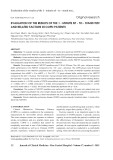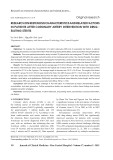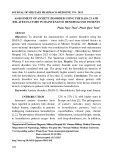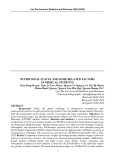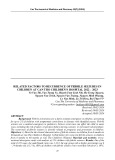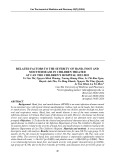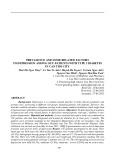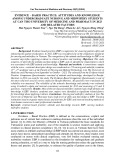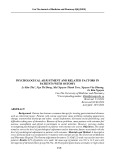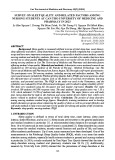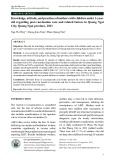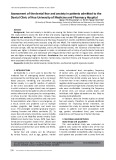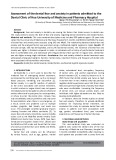
HUE JOURNAL OF MEDICINE AND PHARMACY ISSN 1859-3836
28
Hue Journal of Medicine and Pharmacy, Volume 14, No.2-2024
Assessment of the dental fear and anxiety in patients admitted to the
Dental Clinic of Hue University of Medicine and Pharmacy Hospital
Nguyen Thi Thuy Duong1*, Le Thi Tai1, Nguyen Dinh Hoa2
(1) Faculty of Odonto-Stomatology, University of Medicine and Pharmacy, Hue University
(2) Center of Odonto-Stomatology, Hue Central Hospital
Abstract
Background: Fear and anxiety in dentistry are among the factors that hinder access to dental care.
This study aimed to assess the level of fear and anxiety regarding dental treatments and related factors.
Materials and methods: This cross-sectional descriptive study included 300 patients aged ≥ 18 years who
visited the Hue University of Medicine and Pharmacy Hospital for 5 months (12/2022 to 04/2023), The levels
of dental fear and anxiety were assessed using DFS and MDAS. The relationship between dental fear and
anxiety and the analyzed factors was examined using a multivariate logistic regression model. Results: Of
the total sample, 52% had dentophobia, and 51.7% had dental anxiety. The incidence of dental fear and
anxiety was higher in females compared to males, in individuals with a history of painful dental treatment
than in comfortable ones, and individuals with irregular dental check-ups than in regular ones. Dental fear
was also higher among single individuals. Conclusions: Fear and anxiety related to dental treatment were
widespread among adult patients. Gender, marital status, treatment history, and frequency of dental visits
were associated with dental fear and anxiety.
Keywords: dental fear, dental anxiety, related factors, multivariate logistic regression model.
Corresponding author: Nguyen Thi Thuy Duong; Email: nttduong@huemed-univ.edu.vn
Recieved: 3/10/2023; Accepted: 19/2/2024; Published: 25/2/2024
DOI: 10.34071/jmp.2024.2.4
1. INTRODUCTION
Dentophobia is a term used to describe the
irrational fear of undergoing dental treatment,
accompanied by terrifying signs such as increased
blood pressure, trembling, and discomfort [1].
Dental anxiety is a specific reaction of patients
to the stress associated with dental treatment,
in which unclear or vague stimuli may not appear
immediately [2]. Dental patients who are afraid and
anxious often tend to postpone, be uncooperative,
or refuse to enter the dental clinic. Instead, they
rely on antibiotics and/or painkillers and only come
for examinations when there is an emergency. As
a result, severe oral problems such as multiple
cavities, gingivitis, bad breath, and tooth loss
occur. This prolonged condition gradually impairs
chewing function and affects aesthetics [3]. To
assess fear and anxiety in dentistry, several reliable
scales such as the Modified Dental Anxiety Scale
(MDAS) and Dental Fear Survey (DFS) have been
introduced and applied. Saatchi et al. (2015) used
the MDAS and DFS scales and found that the rates
of anxiety and dental fear were 58.8% and 39.6%,
respectively [4].
Dental fear and anxiety can be influenced
by various factors, such as age, gender, marital
status, educational level, occupation, frequency
of dental visits, and painful experiences during
dental treatment [5]. A study by Kassem et al. in
2021 found that dental anxiety was twice as high
in women than in men. Patients who had previous
negative dental experiences were 3.45 times more
likely to experience high levels of anxiety than those
who were comfortable. Increasing the frequency
of dental visits can reduce anxiety levels, and
individuals with higher education are less likely to
develop dentophobia [6].
In Vietnam, there are limited studies on dental
fear and anxiety. Therefore, to provide additional
evidence for improving dental treatment, we
conducted this study to evaluate dental fear and
anxiety in patients and their associations with
age, gender, educational level, past traumatic
experiences, and frequency of dental checkups.
2. MATERIALS AND METHODS
Study design and population
This cross-sectional study was conducted on
patients who visited the Dental Clinic of the Hue
University of Medicine and Pharmacy Hospital for
5 months (12/2022 to 04/2023). After checking in,
each patient was provided with a survey form and





